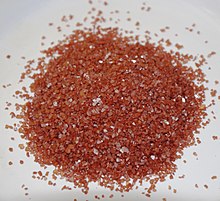Alaea salt
 Hawaiian Alaea salt, an unrefined sea salt that gets its pinkish-brown color from Hawaiian clay ('alaea'). The clay is composed of over 80 separate minerals and is rich in iron oxide | |
| Type | Salt |
|---|---|
| Place of origin | United States |
| Region or state | Hawaii |
| Main ingredients | Salt |
| Ingredients generally used | Red alae volcanic clay |
Alaea salt, sometimes referred to as Hawaiian salt, is an unrefined sea salt that has been mixed with a red alae volcanic clay. It get its pink and brownish color from the particles of volcanic red clay. It is part of Native Hawaiian cuisine and is used to season dishes such as kalua, poke, and pipikaula (Hawaiian jerky). It was also used to cleanse, purify and bless tools, canoes, homes and temples. It was exported for use by salmon fishermen in the Pacific Northwest. It is also used in Native Hawaiian cuisine and fusion style cuisine of Hawaii and is exported.
Most alaea salt sold in the United States is produced in California, not in Hawaii.[1] True Hawaiian salt is expensive[2] and sometimes difficult to find outside the Hawaiian islands.
Overview
Alaea salt was used by Hawaiians to cleanse, purify and bless tools, canoes, homes and temples.[3] Alaea salt is also used in several traditional Hawaiian dishes such as Kalua Pig, Hawaiian Jerky and Poke.[4] In the 19th century Hawaiians began producing large amounts of salt using European salt making techniques and became a leading salt supplier for salmon fishermen in the American Northwest.[5][6]
Color
The salt gets its pinkish-brown color from Hawaiian clay, called alae, which is rich in iron oxide.[7]
See also
References
- ^ Bitterman, Mark (2010). Salted: A Manifesto on the World's Most Essential Mineral, with Recipes. Ten Speed Press. p. 129. ISBN 978-1-58008-262-4.
- ^ Weinzweig, Ari (2003). Zingerman's guide to good eating: how to choose the best bread, cheeses, olive oil, pasta, chocolate, and much more. Houghton Mifflin Harcourt. p. 343. ISBN 978-0-395-92616-1.
- ^ Schrambling, Regina (April 6, 2005). "Salt, that essential flavor" (fee required). Los Angeles Times. Retrieved January 13, 2010.
- ^ "Simply salt, in many variations". The Press Democrat. August 15, 2007. Retrieved January 13, 2010.
{{cite news}}: Unknown parameter|subscription=ignored (|url-access=suggested) (help) - ^ Kurlansky, Mark (2002). Salt: A World History. Penguin Books. p. 405. ISBN 0-8027-1373-4.
- ^ Kurlansky, Mark. pg. 405.
- ^ Laudan, Rachel (1996). The food of Paradise: exploring Hawaii's culinary heritage. University of Hawaii Press. p. 235. ISBN 978-0-8248-1778-7.
